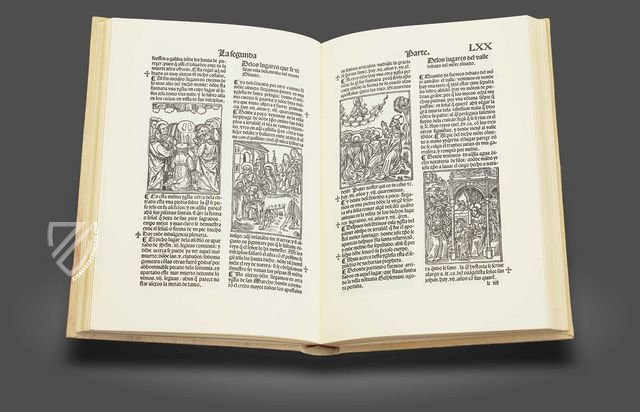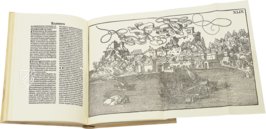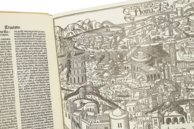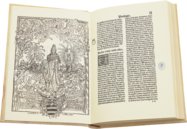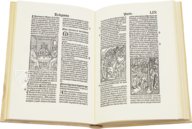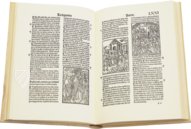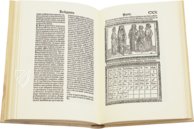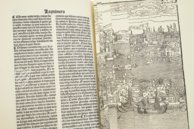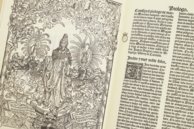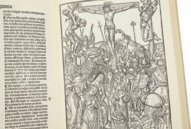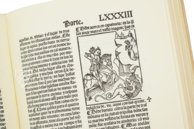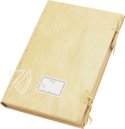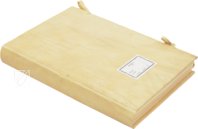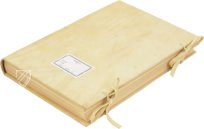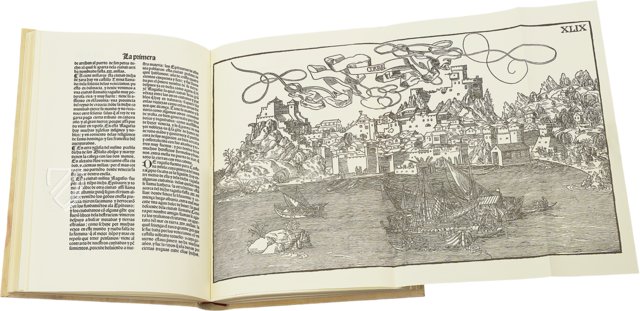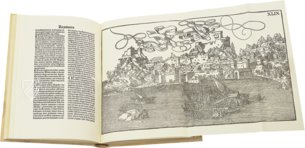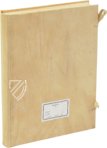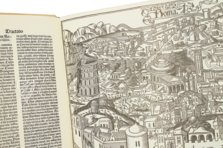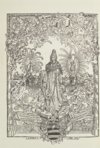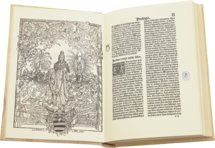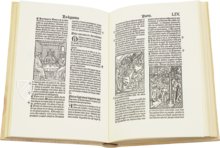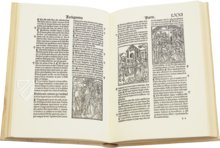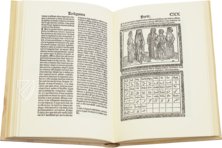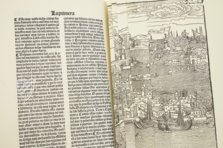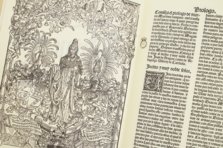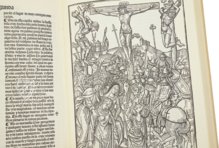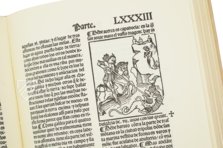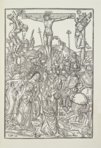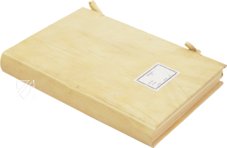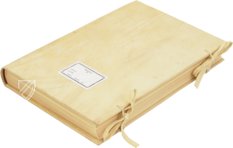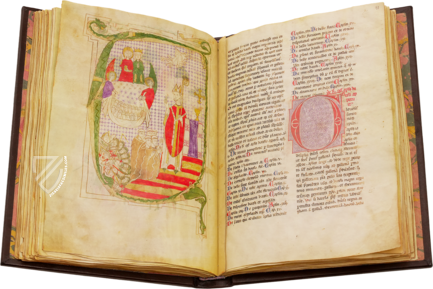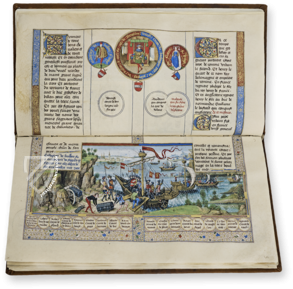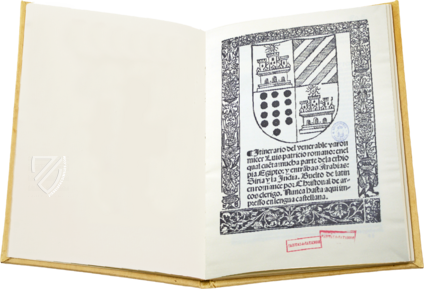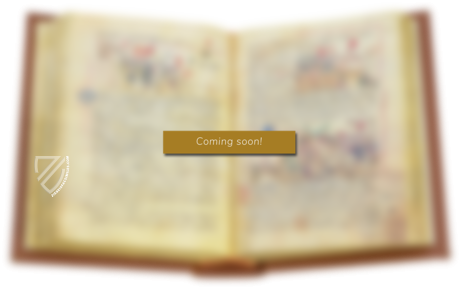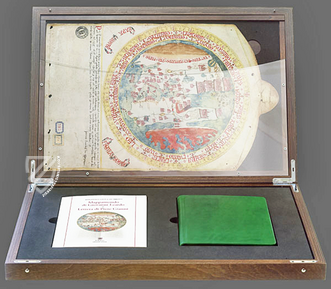Viaje de la Tierra Sancta. Tratado de Roma
(under 1,000€)
A famous late medieval travelogue by Bernhard von Breydenbach (ca. 1440–1497), a politician from the Electorate of Mainz, was published in both Latin and German in 1486 and recounts his pilgrimage to Jerusalem in 1483-4. It was an instant success and appeared in at least 13 editions over the course of the next 30 years, including numerous translations. The woodcuts by Erhard Reuwich (ca. 1450 – ca. 1505) are art-historically significant, representing a number of firsts for graphic art. As such, they were sent across Europe for the numerous editions that followed the Latin and German originals, and were later adopted for other significant works. The 1498 Spanish edition at hand of A Pilgrimage to the Holy Land is arguably the most comprehensive and richly illustrated edition of this bestselling incunabulum (book printed before 1501).
Viaje de la Tierra Sancta. Tratado de Roma
Travelogues were among the most popular literary forms of the Middle Ages, a time when being a world traveler was to be something of a celebrity because of the barriers and dangers ranging from weather to bandits. A famous late medieval travelogue by Bernhard von Breydenbach (ca. 1440–1497), a politician from the Electorate of Mainz, was published in both Latin and German in 1486 and recounts his pilgrimage to Jerusalem in 1483-4. Originally titled Peregrinatio in Terram Sanctam or “A Pilgrimage to the Holy Land” in English, the narrative may have been dictated by Breydenbach, also spelled Breidenbach, to a monk. It was an instant success and appeared in at least 13 editions over the course of the next 30 years, including numerous translations. The woodcuts by Erhard Reuwich (ca. 1450 – ca. 1505) are art-historically significant and were later adapted by Michael Wolgemut (1434–1519) for his 1493 Nuremberg Chronicle. This bestseller is one of the most significant early achievements in the emerging art of printed books.
A Splendid Spanish Edition
This Spanish translation of Martín Martínez de Ampiés (d. ca. 1513), a Catalonian nobleman, soldier, and author, was published on January 16th, 1498 by Pablo Hurus (d. 1505) in Zaragoza and retains the masterful and historic woodcuts of the German original along with the Gothic script. The Spanish translator and the German publisher collaborated on numerous luxury codices at the turn of the 16th century. It is the only edition to feature a cityscape of Rome, which is inspired by a woodcut from the Liber Chronicarum by Hartmann Schedel (1440–1514), first printed in 1493 by Anton Koberger (ca. 1440/45–1513) in Nuremberg, and also features a list of pilgrims to the Holy Land that was appended over the course of the following two centuries. As such, this is arguably the most comprehensive and richly illustrated edition of this bestselling incunabulum (book printed before 1501).
Revolutionary Woodcuts
Erhard Reuwich (ca. 1450 – ca. 1505), a Dutch artist and printer active in Mainz in the 1480’s, was from a family of painters in Utrecht. He is responsible for the woodcuts that adorn the text and accompanied Breydenbach to the Holy Land. His woodcuts represent an artistic milestone in and of themselves. Reuwich’s woodcuts were so highly regarded that they were shipped to other parts of Europe for the text’s various translations – there was simply nothing for local artists to approve upon because the most skilled engravers of this period were almost exclusively German. Even the colophon contains a small artistic milestone: the coat-of-arms of the Archbishop of Mainz features the first cross-hatching in a woodcut. Mainz is additionally featured in an allegorical scene. Aside from the realistic depiction of cities, both in cityscapes and in architectural scenes that possess a surprising degree of perspectival accuracy, the woodcuts are also significant for their size: there are 8 foldout woodcuts, the largest is a panorama of Venice measuring 160 x 30 cm. Other noteworthy woodcuts include a three-block map of Egypt and Palestine, which also represents the oldest surviving printed map of Jerusalem, and five other cityscapes of prominent contemporary Mediterranean metropolises: Iraklion, Modon, Rhodes, Corfu, and Parenzo. Since the travelogue represents a quasi-study of the Near East, it also contains 14 artful depictions of the local dress and animals (though not all of the latter were real), as well as the first printed Arabic alphabet. 66 woodcuts of biblical scenes round out the adornment of this sought-after incunabulum.
Codicology
- Alternative Titles
- Die Reise ins Heilige Land
Peregrinatio in Terram Sanctam - Size / Format
- 372 pages / 30.0 × 20.5 cm
- Origin
- Spain
- Date
- January 16th, 1498
- Epochs
- Style
- Language
- Illustrations
- 8 fold-out city maps and numerous illustrations, xylographic initials
- Content
- Travelogue about pilgrimage to the Holy Land
- Artist / School
- Bernardo de Breidenbach (author)
Martín Martínez de Ampiés (translator)
Pablo Hurus (printer)
Viaje de la Tierra Sancta. Tratado de Roma
Jesus Washes the Disciples Feet
Some Apostles look incredulous, others humbled, but all listen intently as Jesus explains the meaning of this gesture: “If I then, your Lord and Teacher, have washed your feet, you also ought to wash one another’s feet. For I have given you an example, that you should do as I have done to you. Most assuredly, I say to you, a servant is not greater than his master; nor is he who is sent greater than he who sent him. If you know these things, blessed are you if you do them.” (Jn. 13:13-17)
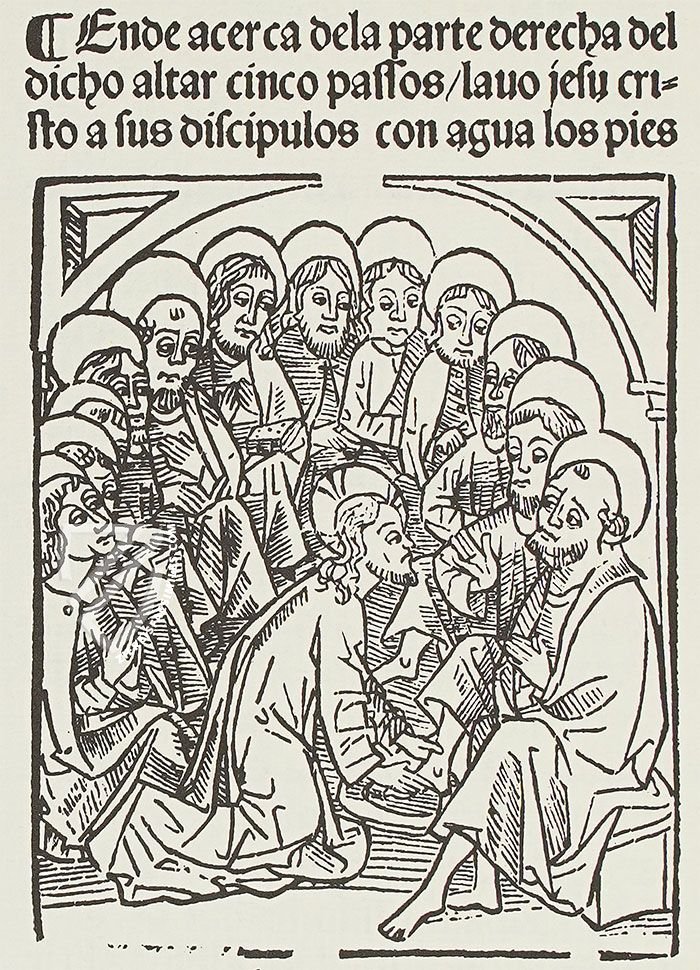
Viaje de la Tierra Sancta. Tratado de Roma
Frontispiece
The frontispiece of this book is undoubtedly one of the finest woodcuts of the 15th century and is a testament to the great skill of Erhard Reuwich. Cross-hatching was used for the first time in the shadows, drapery folds, in the upper part of the shields, and the underside of the top of the frame, which has nine cherubs climbing among the branches.
Saint Catherine, patroness of learned men, stands on a pedestal with her right arm extended toward the coat of arms of Bernard de Breydenbach. His two companions on the pilgrimage to the Holy Sepulchre in Jerusalem and the shrine of St. Catherine on Mount Sinai – John, Count of Solms and Lord of Mintzenberg and a knight named Philip de Bicken – are also represented by shields with banderoles.
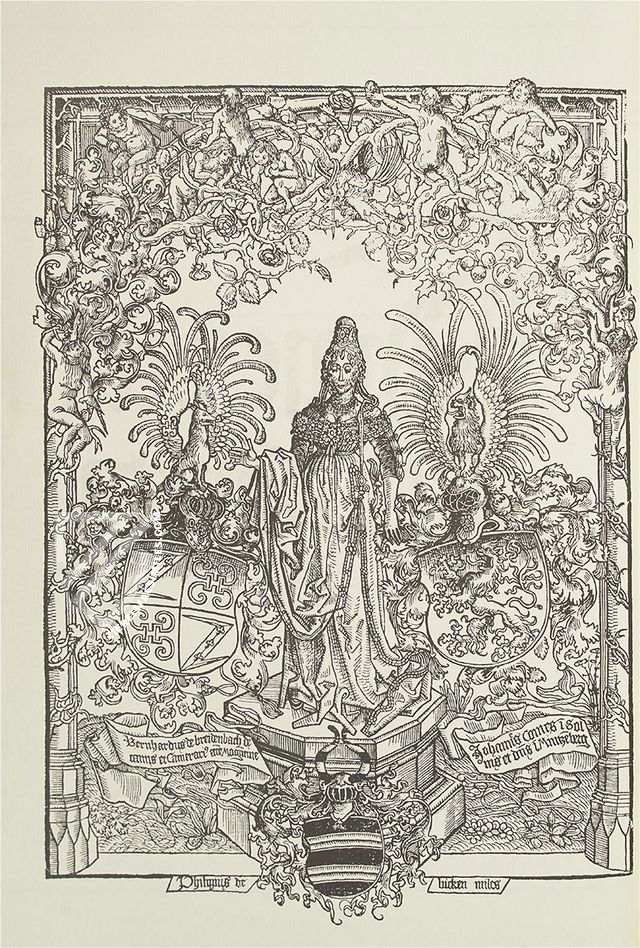
#1 Viaje de la Tierra Sancta. Tratado de Roma
Language: Spanish
(under 1,000€)
- Treatises / Secular Books
- Apocalypses / Beatus
- Astronomy / Astrology
- Bestiaries
- Bibles / Gospels
- Chronicles / History / Law
- Geography / Maps
- Saints' Lives
- Islam / Oriental
- Judaism / Hebrew
- Single Leaf Collections
- Leonardo da Vinci
- Literature / Poetry
- Liturgical Manuscripts
- Medicine / Botany / Alchemy
- Music
- Mythology / Prophecies
- Psalters
- Other Religious Books
- Games / Hunting
- Private Devotion Books
- Other Genres
- Afghanistan
- Armenia
- Austria
- Belgium
- Belize
- Bosnia and Herzegovina
- China
- Colombia
- Costa Rica
- Croatia
- Cyprus
- Czech Republic
- Denmark
- Egypt
- El Salvador
- Ethiopia
- France
- Germany
- Greece
- Guatemala
- Honduras
- Hungary
- India
- Iran
- Iraq
- Israel
- Italy
- Japan
- Jordan
- Kazakhstan
- Kyrgyzstan
- Lebanon
- Liechtenstein
- Luxembourg
- Mexico
- Morocco
- Netherlands
- Palestine
- Panama
- Peru
- Poland
- Portugal
- Romania
- Russia
- Serbia
- Spain
- Sri Lanka
- Sweden
- Switzerland
- Syria
- Tajikistan
- Turkey
- Turkmenistan
- Ukraine
- United Kingdom
- United States
- Uzbekistan
- Vatican City
- A. Oosthoek, van Holkema & Warendorf
- Aboca Museum
- Ajuntament de Valencia
- Akademie Verlag
- Akademische Druck- u. Verlagsanstalt (ADEVA)
- Aldo Ausilio Editore - Bottega d’Erasmo
- Alecto Historical Editions
- Alkuin Verlag
- Almqvist & Wiksell
- Amilcare Pizzi
- Andreas & Andreas Verlagsbuchhandlung
- Archa 90
- Archiv Verlag
- Archivi Edizioni
- Arnold Verlag
- ARS
- Ars Magna
- ArtCodex
- AyN Ediciones
- Azimuth Editions
- Badenia Verlag
- Bärenreiter-Verlag
- Belser Verlag
- Belser Verlag / WK Wertkontor
- Benziger Verlag
- Bernardinum Wydawnictwo
- BiblioGemma
- Biblioteca Apostolica Vaticana (Vaticanstadt, Vaticanstadt)
- Bibliotheca Palatina Faksimile Verlag
- Bibliotheca Rara
- Boydell & Brewer
- Bramante Edizioni
- Bredius Genootschap
- Brepols Publishers
- British Library
- C. Weckesser
- Caixa Catalunya
- Canesi
- CAPSA, Ars Scriptoria
- Caratzas Brothers, Publishers
- Carus Verlag
- Casamassima Libri
- Centrum Cartographie Verlag GmbH
- Chavane Verlag
- Christian Brandstätter Verlag
- Circulo Cientifico
- Club Bibliófilo Versol
- Club du Livre
- CM Editores
- Collegium Graphicum
- Collezione Apocrifa Da Vinci
- Comissão Nacional para as Comemorações dos Descobrimentos Portugueses
- Coron Verlag
- Corvina
- CTHS
- D. S. Brewer
- Damon
- De Agostini/UTET
- De Nederlandsche Boekhandel
- De Schutter
- Deuschle & Stemmle
- Deutscher Verlag für Kunstwissenschaft
- DIAMM
- Droz
- E. Schreiber Graphische Kunstanstalten
- Ediciones Boreal
- Ediciones Grial
- Ediclube
- Edições Inapa
- Edilan
- Editalia
- Edition Deuschle
- Edition Georg Popp
- Edition Leipzig
- Edition Libri Illustri
- Editiones Reales Sitios S. L.
- Éditions de l'Oiseau Lyre
- Editions Medicina Rara
- Editorial Casariego
- Editorial Mintzoa
- Editrice Antenore
- Editrice Velar
- Edizioni Edison
- Egeria, S.L.
- Eikon Editores
- Electa
- Emery Walker Limited
- Enciclopèdia Catalana
- Eos-Verlag
- Ephesus Publishing
- Ernst Battenberg
- Eugrammia Press
- Extraordinary Editions
- Fackelverlag
- Facsimila Art & Edition
- Facsimile Editions Ltd.
- Facsimilia Art & Edition Ebert KG
- Faksimile Verlag
- Feuermann Verlag
- Folger Shakespeare Library
- Franco Cosimo Panini Editore
- Friedrich Wittig Verlag
- Fundación Hullera Vasco-Leonesa
- G. Braziller
- Gabriele Mazzotta Editore
- Gebr. Mann Verlag
- Gesellschaft für graphische Industrie
- Getty Research Institute
- Giovanni Domenico de Rossi
- Giunti Editore
- Graffiti
- Grafica European Center of Fine Arts
- Guido Pressler
- Guillermo Blazquez
- Gustav Kiepenheuer
- H. N. Abrams
- Harrassowitz
- Harvard University Press
- Helikon
- Hendrickson Publishers
- Henning Oppermann
- Herder Verlag
- Hes & De Graaf Publishers
- Hoepli
- Holbein-Verlag
- Houghton Library
- Hugo Schmidt Verlag
- Idion Verlag
- Il Bulino, edizioni d'arte
- ILte
- Imago
- Insel Verlag
- Insel-Verlag Anton Kippenberger
- Instituto de Estudios Altoaragoneses
- Instituto Nacional de Antropología e Historia
- Introligatornia Budnik Jerzy
- Istituto dell'Enciclopedia Italiana - Treccani
- Istituto Ellenico di Studi Bizantini e Postbizantini
- Istituto Geografico De Agostini
- Istituto Poligrafico e Zecca dello Stato
- Italarte Art Establishments
- Jan Thorbecke Verlag
- Johnson Reprint Corporation
- Josef Stocker
- Josef Stocker-Schmid
- Jugoslavija
- Karl W. Hiersemann
- Kasper Straube
- Kaydeda Ediciones
- Kindler Verlag / Coron Verlag
- Kodansha International Ltd.
- Konrad Kölbl Verlag
- Kurt Wolff Verlag
- La Liberia dello Stato
- La Linea Editrice
- La Meta Editore
- Lambert Schneider
- Landeskreditbank Baden-Württemberg
- Leo S. Olschki
- Les Incunables
- Liber Artis
- Library of Congress
- Libreria Musicale Italiana
- Lichtdruck
- Lito Immagine Editore
- Lumen Artis
- Lund Humphries
- M. Moleiro Editor
- Maison des Sciences de l'homme et de la société de Poitiers
- Manuscriptum
- Martinus Nijhoff
- Maruzen-Yushodo Co. Ltd.
- MASA
- Massada Publishers
- McGraw-Hill
- Metropolitan Museum of Art
- Militos
- Millennium Liber
- Müller & Schindler
- Nahar - Stavit
- Nahar and Steimatzky
- National Library of Wales
- Neri Pozza
- Nova Charta
- Oceanum Verlag
- Odeon
- Orbis Mediaevalis
- Orbis Pictus
- Österreichische Staatsdruckerei
- Oxford University Press
- Pageant Books
- Parzellers Buchverlag
- Patrimonio Ediciones
- Pattloch Verlag
- PIAF
- Pieper Verlag
- Plon-Nourrit et cie
- Poligrafiche Bolis
- Presses Universitaires de Strasbourg
- Prestel Verlag
- Princeton University Press
- Prisma Verlag
- Priuli & Verlucca, editori
- Pro Sport Verlag
- Propyläen Verlag
- Pytheas Books
- Quaternio Verlag Luzern
- Reales Sitios
- Recht-Verlag
- Reichert Verlag
- Reichsdruckerei
- Reprint Verlag
- Riehn & Reusch
- Roberto Vattori Editore
- Rosenkilde and Bagger
- Roxburghe Club
- Salerno Editrice
- Saltellus Press
- Sandoz
- Sarajevo Svjetlost
- Schöck ArtPrint Kft.
- Schulsinger Brothers
- Scolar Press
- Scrinium
- Scripta Maneant
- Scriptorium
- Shazar
- Siloé, arte y bibliofilia
- SISMEL - Edizioni del Galluzzo
- Sociedad Mexicana de Antropología
- Société des Bibliophiles & Iconophiles de Belgique
- Soncin Publishing
- Sorli Ediciones
- Stainer and Bell
- Studer
- Styria Verlag
- Sumptibus Pragopress
- Szegedi Tudomànyegyetem
- Taberna Libraria
- Tarshish Books
- Taschen
- Tempus Libri
- Testimonio Compañía Editorial
- Thames and Hudson
- The Clear Vue Publishing Partnership Limited
- The Facsimile Codex
- The Folio Society
- The Marquess of Normanby
- The Richard III and Yorkist History Trust
- Tip.Le.Co
- TouchArt
- TREC Publishing House
- TRI Publishing Co.
- Trident Editore
- Tuliba Collection
- Typis Regiae Officinae Polygraphicae
- Union Verlag Berlin
- Universidad de Granada
- University of California Press
- University of Chicago Press
- Urs Graf
- Vallecchi
- Van Wijnen
- VCH, Acta Humaniora
- VDI Verlag
- VEB Deutscher Verlag für Musik
- Verlag Anton Pustet / Andreas Verlag
- Verlag Bibliophile Drucke Josef Stocker
- Verlag der Münchner Drucke
- Verlag für Regionalgeschichte
- Verlag Styria
- Vicent Garcia Editores
- W. Turnowski Ltd.
- W. Turnowsky
- Waanders Printers
- Wiener Mechitharisten-Congregation (Wien, Österreich)
- Wissenschaftliche Buchgesellschaft
- Wissenschaftliche Verlagsgesellschaft
- Wydawnictwo Dolnoslaskie
- Xuntanza Editorial
- Zakład Narodowy
- Zollikofer AG

